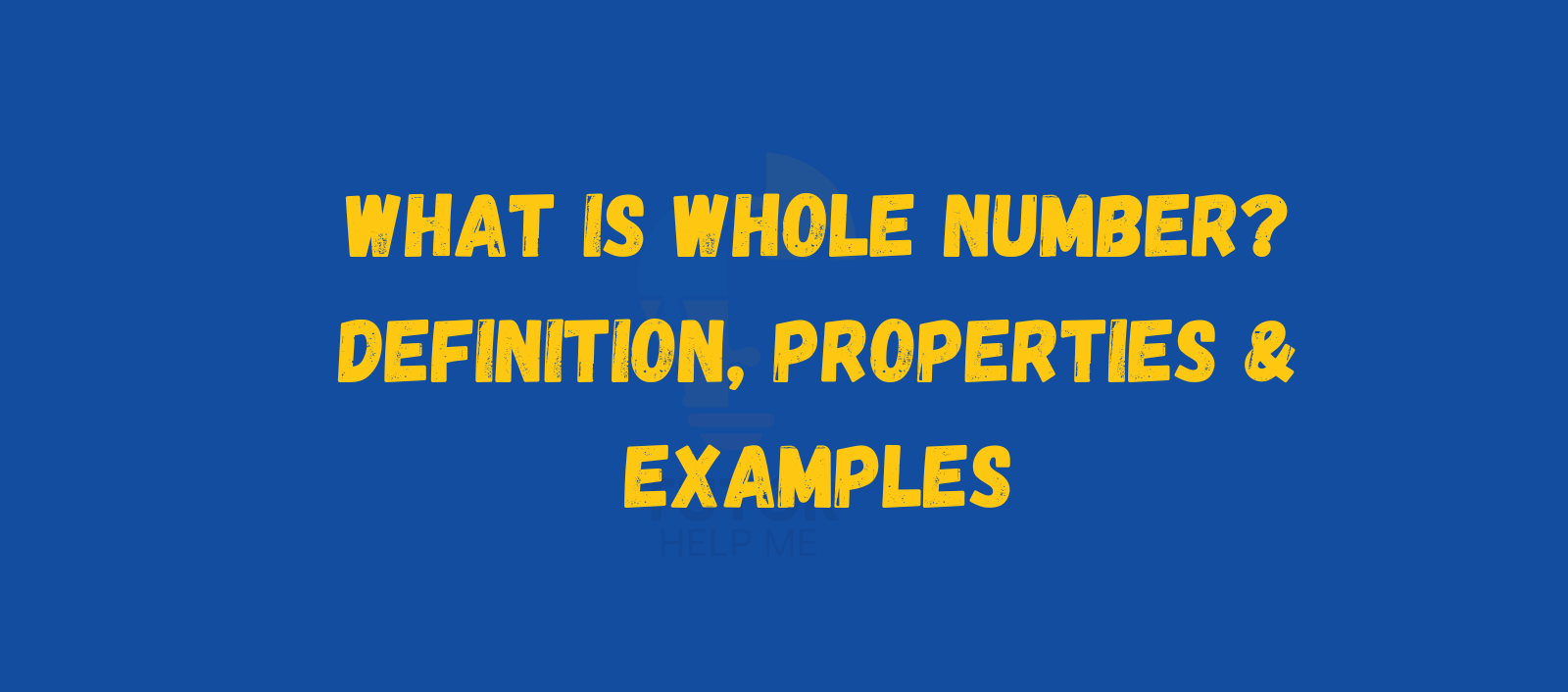Whole numbers are an important part of basic maths. This guide will help you understand their definition, properties, and how they work in daily life.
By the end of this blog, you will know what whole numbers are, how they differ from other types of numbers, and why they matter in both academics and real-life situations.
Let’s start by exploring what whole numbers mean and then move to their key properties and examples.
Definition of Whole Numbers
Whole numbers are numbers without fractions or decimals. They include all natural numbers and zero.
Examples: 0, 1, 2, 3, 4, 5, 6…
Key points:
- No negative numbers are included.
- No fractions or decimal values are included.
- Whole numbers are a subset of integers.
"Get success in maths with our 1-on-1 online maths tutors."
Difference Between Whole Numbers and Natural Numbers
| Feature | Whole Numbers | Natural Numbers |
|---|---|---|
| Includes Zero | Yes | No |
| Starts From | 0 | 1 |
| Negative Numbers | No | No |
Learn more about What are Natural Numbers? Properties & Examples
Difference Between Whole Numbers and Integers
| Feature | Whole Numbers | Integers |
|---|---|---|
| Includes Zero | Yes | Yes |
| Positive Numbers | Yes | Yes |
| Negative Numbers | No | Yes |
| Fractions/Decimals | No | No |
| Example | 0, 1, 2, 3, 4 | -3, -2, -1, 0, 1, 2, 3 |
Properties of Whole Numbers
Whole numbers follow certain mathematical rules that help in calculations.
1. Closure Property
If you add or multiply two whole numbers, the result is always a whole number.
Examples:
- 5 + 3 = 8
- 6 × 4 = 24
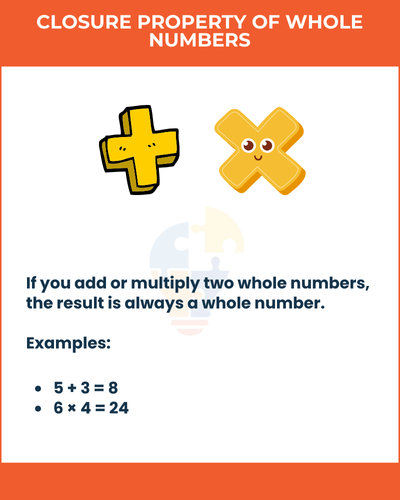
2. Associative Property
Changing the grouping of numbers in addition or multiplication does not change the result.
Addition: (3 + 5) + 2 = 3 + (5 + 2) = 10
Multiplication: (2 × 4) × 3 = 2 × (4 × 3) = 24
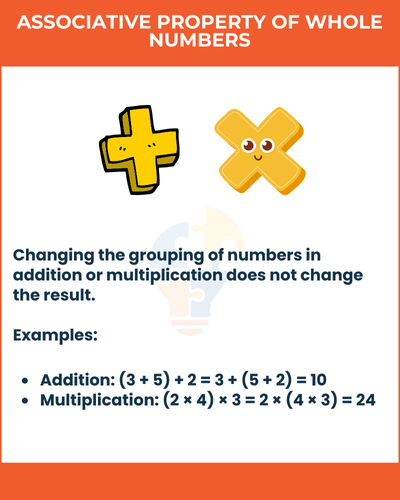
3. Commutative Property
You can change the order of numbers when adding or multiplying, and the answer stays the same.
Addition: 4 + 7 = 7 + 4 = 11
Multiplication: 5 × 9 = 9 × 5 = 45
“Book a free assessment for maths tutoring.”
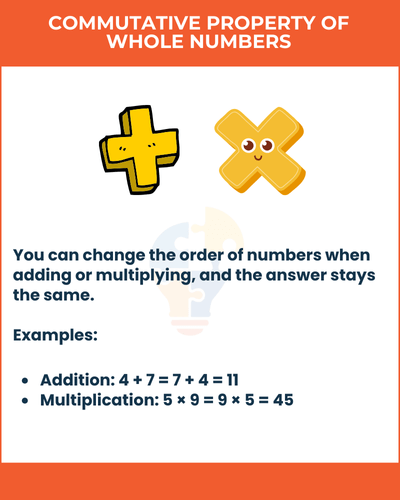
4. Distributive Property
Multiplication can be distributed over addition or subtraction.
Example: 2 × (3 + 4) = (2 × 3) + (2 × 4)
2 × 7 = 6 + 8 = 14
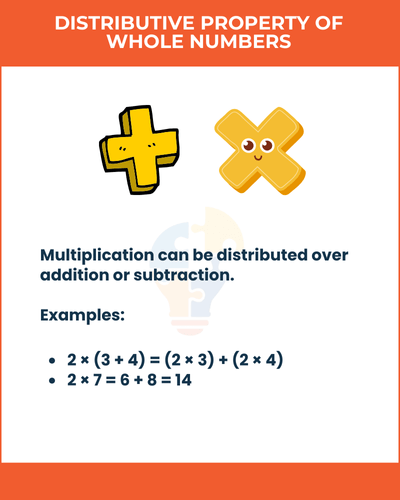
5. Identity Property
Adding zero to a whole number keeps it the same. Multiplying by one also keeps it the same.
Examples:
- 6 + 0 = 6
- 8 × 1 = 8
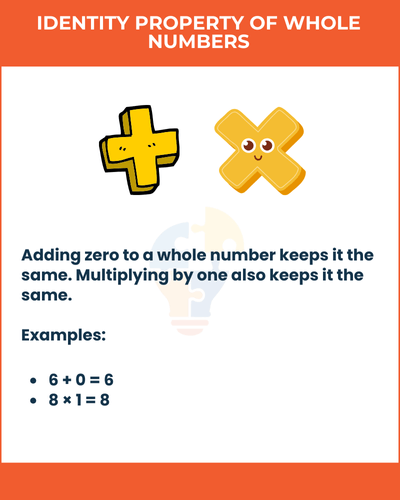
Examples of Whole Numbers in Real Life
- Counting people in a room (0, 1, 2…)
- Number of chairs in a hall
- Page numbers in a book
- Marks scored in a test
- Number of floors in a building
Set Representation of Whole Numbers
The set of whole numbers can be written as:
W = {0, 1, 2, 3, 4, 5, ...}
Number Line Representation
On a number line, whole numbers start at 0 and move to the right without end.
Key Facts About Whole Numbers
- They do not include negative numbers.
- They do not include fractions or decimals.
- Zero is the smallest whole number.
- Whole numbers go on infinitely.
Importance of Whole Numbers
Whole numbers are the foundation for learning other number systems like integers, fractions, and decimals.
They are widely used in counting, measurements, and everyday activities.
Conclusion
Whole numbers are one of the most basic yet important parts of mathematics. They start from zero and include all positive numbers without fractions or decimals.
From counting objects to solving everyday problems, whole numbers are everywhere in our daily lives.
Understanding their properties like closure, commutative, associative, distributive, and identity helps in building a strong foundation for advanced maths topics.
Whether you are a student learning the basics or someone refreshing your knowledge, mastering whole numbers is an essential step in improving your maths skills.
Keep practicing to make your understanding stronger and faster.
Read More Why does the UK academic year start in September?
FAQs
Q1: What is the smallest whole number?
A: The smallest whole number is 0.
Q2: Are all integers whole numbers?
A: No, only non-negative integers are whole numbers.
Q3: Are decimals whole numbers?
A: No, whole numbers do not include decimals.
Q4: Is zero a natural number?
A: No, zero is a whole number but not a natural number.
Q5: Do whole numbers include fractions?
A: No, they only include numbers without fractions or decimals.
Q6: Why are whole numbers important?
A: They are the base for learning all other types of numbers.
Q7: Are all positive numbers whole numbers?
A: No, positive fractions and decimals are not whole numbers.
Q8: Can whole numbers be negative?
A: No, they are always zero or positive.
Q9: How do you represent whole numbers?
A: With the set W = {0, 1, 2, 3, …}.
Q10: Where are whole numbers used in daily life?
A: In counting, labelling, and basic maths operations.

